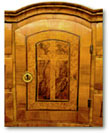


on detail of the desk
|
Secretary Desk: Made in Germany
Date: 1720-1780
ID: 98.46.1
Gift of Ruth Adler Schnee
Sometimes, the look, style, or construction of a piece of furniture can tell us stories about the people who made or owned it. Fancy, grained wood might have been used to show that cost was of no concern, or elaborate carving might demonstrate a craftsman's skill. Everybody has at least one piece of furniture that has a story associated with it. Maybe it's the favorite table that grandma kept in the parlor, and we've all heard of the trunk that came with the European farmer when he immigrated to the New World. Because of the romance associated with immigrant's furniture, it has often been of interest to collectors. But, we don't often associate these things with immigrants coming to the United States in the 20th century.
This desk, a recent gift to The Henry Ford, surmounted by a storage cabinet that combines drawers and a center tabernacle door is just such a piece. It was probably originally constructed around the middle of the 18th century in Germany. The desk-bookcase is very decoratively veneered; it even includes a crucifixion scene on the central door of the top section made out of little bits of wood. However, unlike the 19th century immigrant's trunk, this desk reminds us of a story of the dispossession of an educated, sophisticated people. It reminds us of the story of one family of German Jews in the 1930s.
The donor's family had lived in Frankfurt, Germany since the thirteenth century, and for most of that time, they were involved in the book trade. Her father later added antiques to the business. Her mother inherited the desk, and the donor remembers her family using it in their home. As a child, she wondered at the inlaid crucifixion scene on the door, thinking it odd since the family was Jewish. With the rise of the Nazi regime, harassment and restrictions to the family increased until, on Kristalnacht in 1938, their home was ransacked. The family had been warned by friends to leave the house just before. When they returned, most of the furniture, including this desk, and almost everything else had been thrown into the central courtyard of the multi-storied apartment building. The next day, her father was arrested and sent to the Dachau concentration camp. The donor's mother contacted various important connections that she had in Holland and Belgium to help find a way to free her husband. At the same time, she had the furniture repaired as the Nazis required her to do and began to make plans to leave Germany. In 1939, her husband was finally freed. The family sent two van loads of furniture to New York and in spite of much resistance from the donor's father, the family began their journey to the New World. The donor was a girl of just 15. They made their way to Detroit, where there was to be a job waiting. Through very difficult years, this desk with its tabernacle top was a symbol of the life they left behind. It was a symbol that helped the parents to survive until finally, they were able to carve out new lives for themselves. For us it can serve as a symbol too. It can tell us of the different backgrounds that have come together to make our community the interesting and diverse nation that it is.
|

